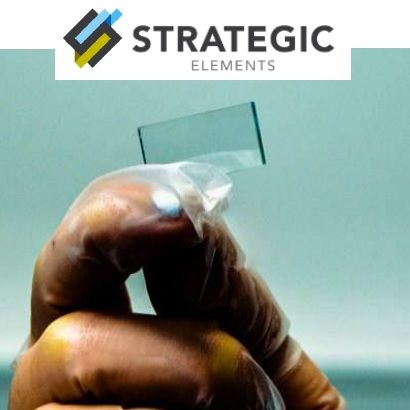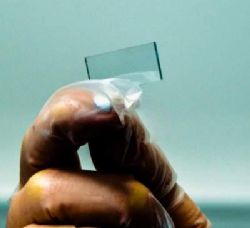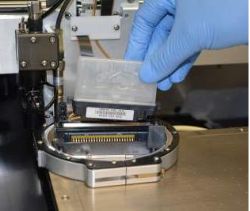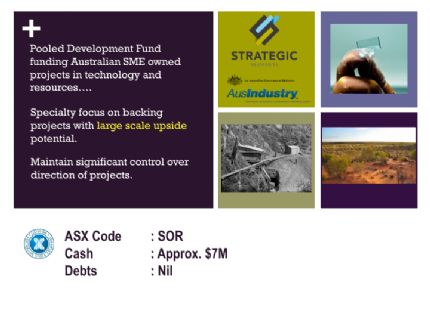 Significant Development in Glass Based Transparent Memory Device
Significant Development in Glass Based Transparent Memory Device
Perth, May 24, 2016 AEST (ABN Newswire) - An Australian University invented technology has enabled a glass based transparent memory device to remember the same piece of information 100,000 times.
It has been announced today that a glass based memory device prototype was successfully fabricated with transparent memory technology by ASX listed Strategic Elements ( ASX:SOR) together with a materials research team from the University of New South Wales.
ASX:SOR) together with a materials research team from the University of New South Wales.
The team has created a transparent memory ink designed to be printed onto materials such as silicon, glass and plastics using traditional low cost printing methods outside of billion-dollar silicon chip fabrication plants.
Highly innovative new glass based materials are considered by many to be central to the Printed Electronics sector which is forecast to grow to USD 70.4 billion by 2024. Memory is at the heart of all electronics.
Endurance measurements for reliability of a Nanocube memory cell revealed:
- The glass based prototype was highly reliable and capable of storing and retrieving the same piece of information 100,000 times with no signs of degradation.
- Despite existing silicon chip based Flash memory being produced in billion-dollar fabrication plants, the endurance capability still ranges from only 10,000 cycles to 100,000.
- Equipment used by the Company could not measure endurance beyond 100,000 cycles and therefore, the final maximum limit is still to be determined. Exceptional reliability may be a strong feature of the Nanocube Memory technology.
Transparent conductive material was coated as the bottom electrode on the surface of the glass, then Nanocube Memory Ink was coated onto the transparent material. Subsequently, ultra small silver top electrodes were deposited to form the transparent memory device.
Optical measurements for transparency revealed:
- The glass based prototype device was highly transparent with 70%-80% transparency. This is much higher than the definition of transparency in electronics.
- Transparent electronic devices are the ultimate goal of many large global consumer electronic companies.
The Company is currently undergoing the development and IP work required to showcase the memory technology to potential partners. Additionally, it is also sourcing and using various materials from companies across the supply chain. Further developments will be reported in the near term.
Managing Director, Charles Murphy said, "We are starting to be able to communicate some of the benefits of the technology publically, however, we are still being guided as to timing and nature of disclosure by our patent team and with sensitivity to any potential partner.
We are extremely pleased with the strength of relationship with the materials research team at UNSW and will be seeking to expand our current relationship with them in the near future."
Presentation
Though Printed Electronics printing, paper, plastic, glass and chemical companies have the opportunity to become the new electronic giants of tomorrow. The Company recommends shareholders and investors to view its recent short presentation on the Printed Electronics sector on the homepage of its website at www.strategicelements.com.au.
Background Australian Advanced Materials Pty Ltd (AAM), 100% owned by Strategic Elements Ltd., has transitioned from having an exclusive global licence for the technology from UNSW, to now having full assignment and ownership of the technology. AAM has contracted the materials group at the UNSW School of Materials Science and Engineering to assist in developing the technology and creating new Intellectual Property.
- Nanocube memory technology is based on RRAM which potentially allows faster, less power hungry, more reliable, cheaper and more scalable memory.
- However, the Nanocube technology potentially has extra significant points of difference to be flexible, transparent and able to be fabricated into a liquid solution at room temperature outside expensive high-vacuum chambers.
- The obvious fit is Printed Electronics (PE) where chemical, printing and electronic industries have collaborated to create a multi-billion dollar market that will be the future of electronics.
- PE can create flexible, transparent electronics which current semiconductors cannot. PE can also be manufactured using cheap printing methods unlike current electronics made in expensive fabrication plants.
- This creates opportunities to (a) allow device manufacturers to produce flexible products and (b) put electronics in places and on products that have never been able to use electronics before.
- In December 2015 testing results were released clearly demonstrating the potential of the technology.
- In March 2016 an enhanced method of prototype fabrication commenced. ASX Listed Strategic Elements Ltd The Company has a special registration from the Federal Government as a Pooled Development Fund enabling eligible shareholders to pay no capital gains tax when they sell their shares in ASX listed Strategic Elements ( ASX:SOR). In return the Company must back only Australian SME's.
ASX:SOR). In return the Company must back only Australian SME's.
About Strategic Elements Ltd
 Strategic Elements (ASX:SOR) shares are listed on the Australian Stock Exchange under the code “SOR”. The Company is registered under the Pooled Development Program run by the Australian Federal Government to encourage investment into SME’s. To assist Pooled Development Fund’s to invest and raise capital, the Federal Government enables most shareholders in a Pooled Development Fund to make capital gains and receive dividends tax-free.
Strategic Elements (ASX:SOR) shares are listed on the Australian Stock Exchange under the code “SOR”. The Company is registered under the Pooled Development Program run by the Australian Federal Government to encourage investment into SME’s. To assist Pooled Development Fund’s to invest and raise capital, the Federal Government enables most shareholders in a Pooled Development Fund to make capital gains and receive dividends tax-free.
![abnnewswire.com]()
Related Companies
Social Media
Share this Article

 ASX:SOR) together with a materials research team from the University of New South Wales.
ASX:SOR) together with a materials research team from the University of New South Wales.  ASX:SOR). In return the Company must back only Australian SME's.
ASX:SOR). In return the Company must back only Australian SME's.  Strategic Elements (ASX:SOR) shares are listed on the Australian Stock Exchange under the code “SOR”. The Company is registered under the Pooled Development Program run by the Australian Federal Government to encourage investment into SME’s. To assist Pooled Development Fund’s to invest and raise capital, the Federal Government enables most shareholders in a Pooled Development Fund to make capital gains and receive dividends tax-free.
Strategic Elements (ASX:SOR) shares are listed on the Australian Stock Exchange under the code “SOR”. The Company is registered under the Pooled Development Program run by the Australian Federal Government to encourage investment into SME’s. To assist Pooled Development Fund’s to invest and raise capital, the Federal Government enables most shareholders in a Pooled Development Fund to make capital gains and receive dividends tax-free.






